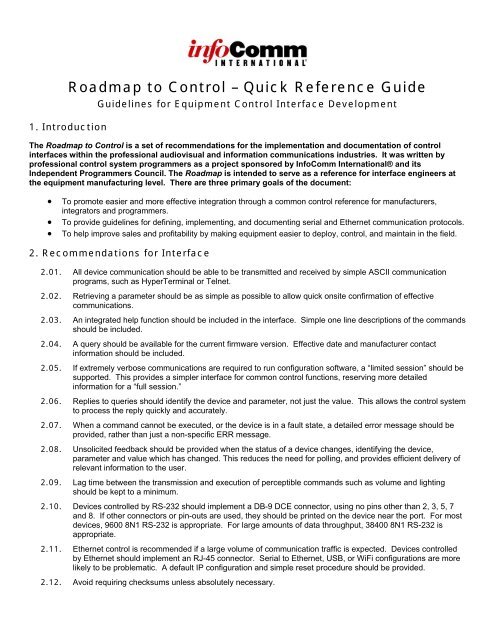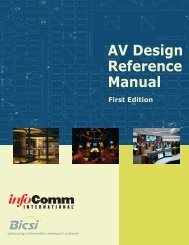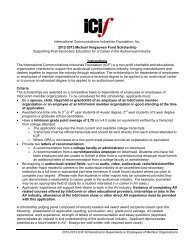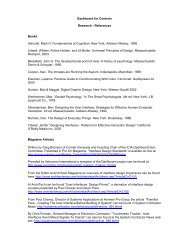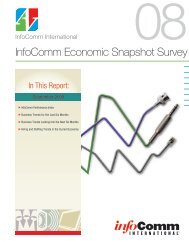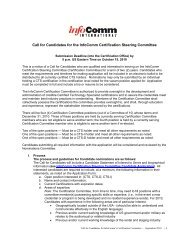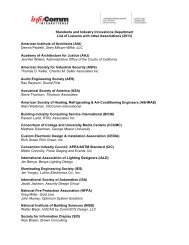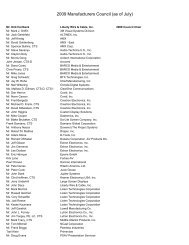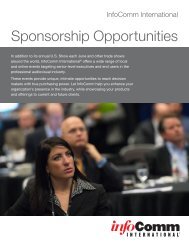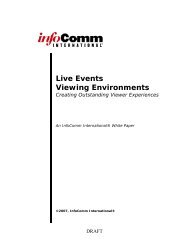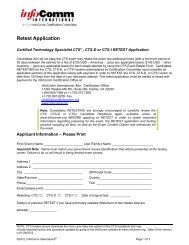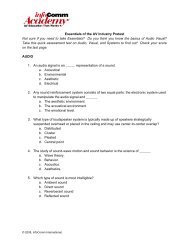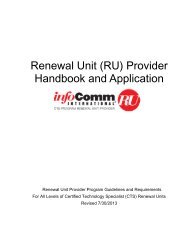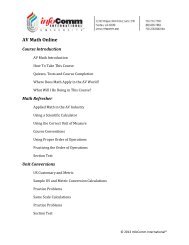Roadmap to Control – Quick Reference Guide - InfoComm
Roadmap to Control – Quick Reference Guide - InfoComm
Roadmap to Control – Quick Reference Guide - InfoComm
You also want an ePaper? Increase the reach of your titles
YUMPU automatically turns print PDFs into web optimized ePapers that Google loves.
<strong>Roadmap</strong> <strong>to</strong> <strong>Control</strong> <strong>–</strong> <strong>Quick</strong> <strong>Reference</strong> <strong>Guide</strong><br />
1. Introduction<br />
<strong>Guide</strong>lines for Equipment <strong>Control</strong> Interface Development<br />
The <strong>Roadmap</strong> <strong>to</strong> <strong>Control</strong> is a set of recommendations for the implementation and documentation of control<br />
interfaces within the professional audiovisual and information communications industries. It was written by<br />
professional control system programmers as a project sponsored by <strong>InfoComm</strong> International® and its<br />
Independent Programmers Council. The <strong>Roadmap</strong> is intended <strong>to</strong> serve as a reference for interface engineers at<br />
the equipment manufacturing level. There are three primary goals of the document:<br />
• To promote easier and more effective integration through a common control reference for manufacturers,<br />
integra<strong>to</strong>rs and programmers.<br />
• To provide guidelines for defining, implementing, and documenting serial and Ethernet communication pro<strong>to</strong>cols.<br />
• To help improve sales and profitability by making equipment easier <strong>to</strong> deploy, control, and maintain in the field.<br />
2. Recommendations for Interface<br />
2.01. All device communication should be able <strong>to</strong> be transmitted and received by simple ASCII communication<br />
programs, such as HyperTerminal or Telnet.<br />
2.02. Retrieving a parameter should be as simple as possible <strong>to</strong> allow quick onsite confirmation of effective<br />
communications.<br />
2.03. An integrated help function should be included in the interface. Simple one line descriptions of the commands<br />
should be included.<br />
2.04. A query should be available for the current firmware version. Effective date and manufacturer contact<br />
information should be included.<br />
2.05. If extremely verbose communications are required <strong>to</strong> run configuration software, a “limited session” should be<br />
supported. This provides a simpler interface for common control functions, reserving more detailed<br />
information for a “full session.”<br />
2.06. Replies <strong>to</strong> queries should identify the device and parameter, not just the value. This allows the control system<br />
<strong>to</strong> process the reply quickly and accurately.<br />
2.07. When a command cannot be executed, or the device is in a fault state, a detailed error message should be<br />
provided, rather than just a non-specific ERR message.<br />
2.08. Unsolicited feedback should be provided when the status of a device changes, identifying the device,<br />
parameter and value which has changed. This reduces the need for polling, and provides efficient delivery of<br />
relevant information <strong>to</strong> the user.<br />
2.09. Lag time between the transmission and execution of perceptible commands such as volume and lighting<br />
should be kept <strong>to</strong> a minimum.<br />
2.10. Devices controlled by RS-232 should implement a DB-9 DCE connec<strong>to</strong>r, using no pins other than 2, 3, 5, 7<br />
and 8. If other connec<strong>to</strong>rs or pin-outs are used, they should be printed on the device near the port. For most<br />
devices, 9600 8N1 RS-232 is appropriate. For large amounts of data throughput, 38400 8N1 RS-232 is<br />
appropriate.<br />
2.11. Ethernet control is recommended if a large volume of communication traffic is expected. Devices controlled<br />
by Ethernet should implement an RJ-45 connec<strong>to</strong>r. Serial <strong>to</strong> Ethernet, USB, or WiFi configurations are more<br />
likely <strong>to</strong> be problematic. A default IP configuration and simple reset procedure should be provided.<br />
2.12. Avoid requiring checksums unless absolutely necessary.
<strong>Roadmap</strong> <strong>to</strong> <strong>Control</strong> <strong>–</strong> <strong>Quick</strong> <strong>Reference</strong> <strong>Guide</strong><br />
<strong>InfoComm</strong> International<br />
<strong>Guide</strong>lines for Equipment <strong>Control</strong> Interface Development May 2006<br />
3. Recommendations for Documentation<br />
3.01. The control interface documentation should be included in the user’s manual and be easily accessible.<br />
Provide it in print or on CD-ROM in the device box and for public download on the manufacturer’s website as<br />
a PDF file.<br />
3.02. The opening section of any control interface technical documentation should be a brief description of the<br />
capabilities of the control interface and available commands.<br />
3.03. Documentation should include contact information for the technical support department responsible for the<br />
device. This should include a generic e-mail address, telephone number, and web address (<strong>to</strong> check for an<br />
updated document before contacting tech support).<br />
3.04. All numeric values should be carefully defined in scale as well as representation. A valid range should be<br />
provided for each command or query that contains numeric data.<br />
3.05. A different font (e.g., Courier) should be used <strong>to</strong> clearly distinguish between the text of the document and<br />
sample strings that would be sent <strong>to</strong> or received from the device.<br />
3.06. Each command, query, and reply should be fully detailed in the device’s technical documentation, including<br />
examples. Even if the control pro<strong>to</strong>col is based on an existing standard, such as Telnet or XML, full details<br />
should still be provided.<br />
3.07. Documentation on serial connections should include details about the type and gender of connec<strong>to</strong>r used,<br />
the function of each connec<strong>to</strong>r pin, data transmission speed (baud rate), command spacing requirements<br />
(time required between commands), character spacing, character length (data bit), parity bit, s<strong>to</strong>p bit.<br />
Hardware or software flow control settings should be included, even if the requirement is NONE.<br />
3.08. Devices controlled by means of an Ethernet connection require the default IP address, specifications about<br />
TCP/IP or UDP/IP communication, the port number on which the connection will occur, and default user<br />
name and password if required. Instructions should also be provided for resetting the default IP address.<br />
Login, authentication or handshaking sequences required <strong>to</strong> open a session should also be detailed.<br />
3.09. As an example, each byte of the formatting of one valid command should be thoroughly detailed. Describe<br />
any preamble or header, addressing scheme, command, data, check sum, and delimiter or end byte. Include<br />
information about responses from the device, such as acknowledgments or error messages.<br />
3.10. A list of all available commands should be provided, including the applicable data for each command, a<br />
usage example, and expected replies.<br />
3.11. All available queries should be outlined, carefully detailing the responses that can be expected from the<br />
device for each query.<br />
3.12. Error replies generated by the device when replying <strong>to</strong> commands or queries should be outlined in detail,<br />
defining each potential error code or condition.<br />
3.13. Each command or query should be listed with a full example of both transmitted and received data, so a<br />
dedicated “example” section at the end of the document should not be required. Manufacturers may find it<br />
advantageous <strong>to</strong> have sample programs for popular control systems available for download from their<br />
websites.<br />
Revision 1.0 4/27/2006 <strong>–</strong> Download the full document at http://www.infocomm.org/roadmap.<br />
<strong>InfoComm</strong> International®, 11242 Waples Mill Road, Suite 200, Fairfax VA 22030 U.S.A. 800.659.7469 www.infocomm.org


